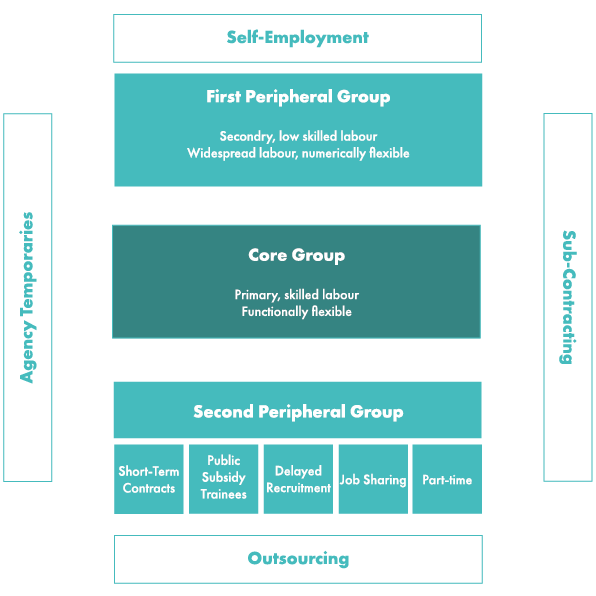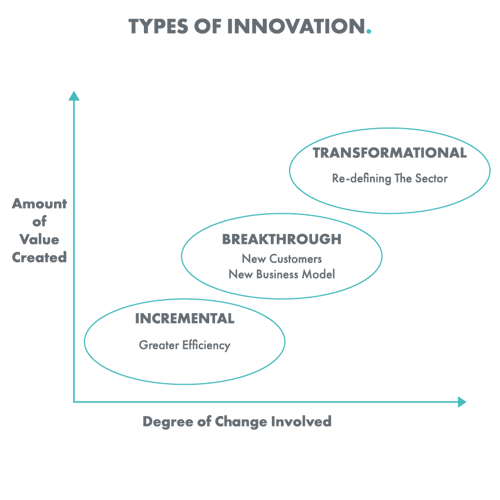
In my first year at University, I read the brilliant book by Rosabeth Moss Kanter called “When Giants Learn to Dance”. Amongst other themes, she explored how extremely large multinational organisations were still able to remain flexible, dynamic and responsive to the business environments they were operating in. In other words, how they were continuously able to innovate and change in spite of their size. At the time in the early 1990s this was seen as the Holy Grail of business success, being large enough to withstand the buffeting of the wider business environment, yet at the same time having a culture that enabled rapid and assertive responses to the challenges they were facing.
Even before this John Atkinson in 1984 developed the model of the ‘Flexible Firm’.

Where he had observed organisations developing operating models that included a small ‘Core’ team of functional activity, being supported by peripheral groups dependent on need and then a whole range of wider Stakeholders operating at the boundaries of the organisation as and when required.
Of course, since the late 1990s, technological innovation has enabled many organisation to adopt this model to an even greater extent and has created unparalleled opportunities for innovation. Since any person or thing can connect with any other person or thing, instantly and at zero cost, everything that human beings do and where they do it has been reinvented. I have a friend who makes a very good living as an accountant who lives on a yacht with his partner who also makes a good living as a PR consultant, both for a variety of organisations in the UK, yet they have spent the last six years constantly sailing around the world and have not stepped foot in the UK. Everything is completed remotely, with the use of the occasional ‘Go to’ meeting. Even when crossing the Atlantic to the Caribbean, accounts were finalised and articles written through the use of a Sat Phone.
If this is the case, then why is that, in general, most large organisations lag on transformational innovation. Why? Why after all this time have they not yet learnt to dance? Why do they find innovation so difficult and very often frightening?
A colleague who conducts innovation workshops for executives from big organisations around the world is puzzled and too often berates himself that his work for the past twenty years has been a waste of time. “What I find everywhere is people who don’t know how to innovate, Having conducted workshops with over 500 teams from leading organisations around the world and after forming about 100 projects and innovations with global companies and governments, what I find is a lack of the ‘how’ and not the ‘what.’ I have never met a manager or executive who thought other than you grew the business by creating value for customers. They had great people, lots of money, and abundant opportunity, but poor results.”
The problem is that these large organisations have neither the strategic focus nor the agility needed to undertake transformational innovation.
What is Innovation?
Innovation is a new idea, creative thoughts, new imaginations in the form of device or method. Innovation is often also viewed as the application of better solutions that meet new requirements, unarticulated needs, or new ways to meet the needs of an existing market.

Studies into innovation indicate there are three levels, as illustrated above.
- Incremental - Where there is a minimum level of change and the amount of value created for the organisation is fairly minimal, e.g. changing from one brand of truck to another and instead of buying them outright leasing them, which will lead to lower monthly operating costs eventually.
- Breakthrough - Where there is some definite tangible recognisable long term change within the organisation that then leads to significant increases in value e.g. the development and implementation of a new operating model that requires staff to have a different skill set using and operating with their customers in a very different way.
- Transformational - Involves a high level of change and adds huge amounts of value to the organisation e.g. moving into a completely new market.
Too often, I have found that strong creatives, entrepreneurs, innovatives and ideas people are not valued as employees. They are considered to be a challenge to manage by managers who want the skills they bring to the table, yet at the same time are very frightened about the way in which they operate within organisations. They are often seen as ‘not fitting in’, mavericks or just simply not the right type of person. They find themselves being gradually ‘managed’ out of the organisation, or that they themselves find the organisation so stifling that they simply leave. This is particularly the case in long-established organisations and the public sector.
Innovation in the Public Sector
Starting with governments. Most government agencies, for us that’s the Civil Service involve the administration of existing policies and goals. Their mission is often given by law. The norms of how the mission is to be carried out often have a similar degree of permanence. A bold new innovation with fresh value for customers is not part of their world.
"Innovation" in the case of the Department of Justice, or the Home Office means delivering the existing mission a bit more efficiently or effectively, but the same mission. Essentially their executives are administrators. Innovation in the sense of creating bold new value for customers doesn't enter their world.
Often they have not been employed to be creative or innovative, just to deliver. They have a permanently furrowed brow and very low lines of site in terms of setting and establishing a culture of high expectations. There are occasionally exceptions to this, most likely when a crisis hits, when some departments in the Civil Service do get creative. In the USA this is very similar. It wasn’t until in the 2008 crisis, the Federal Reserve Bank actually got creative in their response, as outlined in Ben Bernanke’s book, The Courage to Act (W.W.Norton, 2015). But they merely adjusted the way it administered their existing mission when they found their existing models weren't working. But their mission didn't change (low inflation and low unemployment). Their ‘customers’ remained the same. The value they provided remained the same. They came up with a new gadget to achieve the same goal. In the UK the Bank of England being steered by the Canadian economist Mark Carney, did exactly the same with their policy of Quantitative Easing.
This was an incremental innovation, not a transformational innovation that redefined the role of the central bank. They had a little burst of incremental innovation in 2008, for which we should all be grateful. Then they went back to doing what they had always done - administering a national bank. That's their job. It’s maybe not a bad thing that they concentrate on that job and leave transformational innovation to others.
Innovation in private sector organisations
Until recently, most large business organisations were a little different. They stuck to their “core" business activity and operating models. When they deviated from their core, they generally failed. The people who ran those organisations were, like their confreres in government, administrators. They attended business school and got degrees aptly labelled "Master of Business Administration."
These executives mostly tended the status quo. They were not seriously involved in innovation. They saw themselves as mainly exploiting their existing business models, trying to squeeze as much out of the market as possible and only explored alternatives at the margin.
The disruptors and the disrupted
Over the last decade or so, we started to see some large organisations being run differently. Firms like Amazon, Google and Facebook embraced agility and became able to launch major innovations and succeed in sectors that were far from their original business.
Meanwhile many big firms found themselves started getting seriously disrupted by upstarts. So their executive-administrators started attending workshops on "innovation", often ran by my colleague. The creation of bold new customer value was not the goal of these firms, any more than it was for government departments.
For several decades, most of them had been pursuing “maximising shareholder value”, which ended up putting an emphasis on short-term gains in the stock market and de-emphasising transformational innovation.
Today, as maximising shareholder value becomes discredited, big firms are starting to get lost in the fog of stakeholder innovation, with the consequent risk that transformational innovation will still be short-changed. Without an obsessive focus on adding value to customers, it is unlikely that many firms will stumble on transformational innovation, because they fundamentally have a lack of ability to adapt. Moreover, most of these large firms are still organised as bureaucracies based on models developed by the German sociologist Max Weber that are the antithesis of the agility required for bold new innovation. Gary Hamel states “Strategy gets set at the top. Power trickles down. Big leaders appoint little leaders. Individuals compete for promotion. Compensation correlates with rank. Tasks are assigned. Managers assess performance. Rules tightly circumscribe discretion.”
A lack of focus on transformational innovation
Surveys by Deloitte and McKinsey suggested that less than 10% of big firms were making real progress in becoming more adaptive and agile. More recently, a survey of several thousand executives, published in strategy + business carried out by PwC, indicates that 23% of the executives work in corporations that are actively trying to redefine their core business model and fundamentally change the way they operate..
The rest fall into three groups.
- Group one - wants to modernise to improve on what it already does
- Group two - focused on increasing speed and efficiency
- Group three - keen to break new ground in its industry
There is little point of discussing with these people "how" to redefine their businesses and create bold new innovation unless and until there is more agreement that this is "what" their organisations should be focused on, namely, continuous innovation for customers and how they should be organised to accomplish it. For me though, more important that this are they employing creatives and nurturing their skills, as it these individuals who will deliver new ways of working and operating.
All the successful entrepreneurs in the new ways of operating all have creativity in common with each other and they also have desire to recruit, respect, and nurture and develop these creatives in the long term. Together they have created organisations that have concentrated on delivering value to customers. The principal reason they have been so successful is that they have delivered to customers the gold standard of corporate performance: instant, frictionless, intimate, interconnected value at scale. Firms that can deliver this have become rich beyond the dreams of avarice. Those that can’t are still struggling.
About Ascento
Ascento learning and development specialise in providing workforce development apprenticeship programmes to both apprenticeship levy paying employers and non levy employers. We work closely with employers to identify the key areas for development and design strategic solutions to tackle these with programmes that are tailored to each individual learner. With two schools of excellence focusing on Management and Digital Marketing we don’t deliver every qualification under the sun, but focus on what we know best and ensure that quality is at the heart of everything we do.








